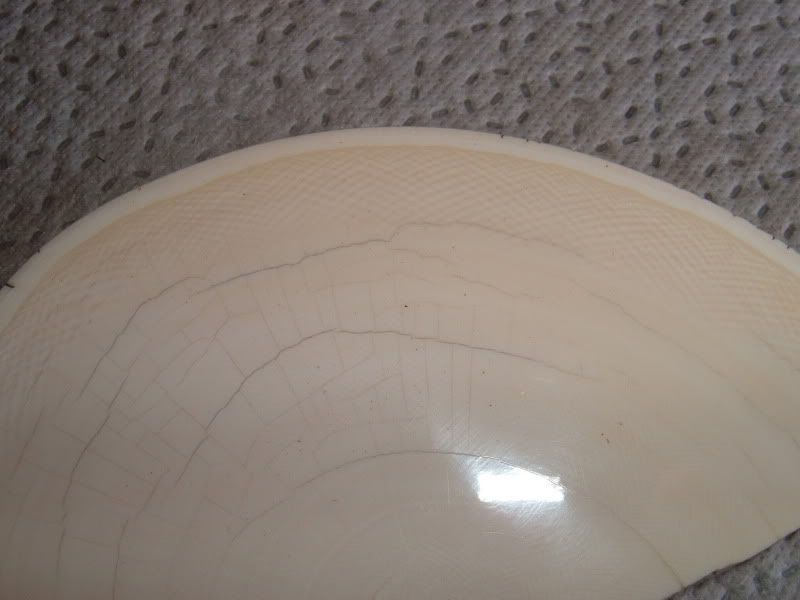Results 1 to 10 of 40
Thread: Identifying Ivory
Hybrid View
-
06-19-2012, 02:00 PM #1Seņor Member (the name is Dave)


- Join Date
- Feb 2012
- Location
- Sarver, Pennsylvania, United States
- Posts
- 683
Thanked: 88 Identifying Ivory
Identifying Ivory
I've never seen or touched real ivory, so I don't think I'd recognize it. I think some scales that I recently acquired are ivory, even though I originally identified them as bone. They were very dirty at first, and the grain lines looked like bone scales I've seen. I soaked them briefly in Oxyclean, and they developed a slightly slimy feel (probably just the Oxyclean). Once dry, I sanded lightly up to 2000 and polished with metal polish, and they are very glossy now like plastic. They are very thin and light. Definately not plastic.
Last edited by DFriedl; 06-19-2012 at 02:16 PM.
-
06-19-2012, 02:08 PM #2Senior Member


- Join Date
- Jan 2011
- Location
- Roseville,Kali
- Posts
- 10,432
Thanked: 2027
Post a pic taken in natural sunlight,the diff between ivory and bone is very apparant.
-
06-19-2012, 02:15 PM #3Seņor Member (the name is Dave)


- Join Date
- Feb 2012
- Location
- Sarver, Pennsylvania, United States
- Posts
- 683
Thanked: 88
Thanks. I'm at work at the moment, but I assume it's sort of translucent around the edges, like horn is?
-
06-19-2012, 02:19 PM #4

Ivory are much smoother than bone, bone is also more porous.
One way to help identify ivory is to knock it gently against your teeth, they will make a sound like clicking your teeth together.
Since you have sanded them the smell should also be a indicator, bone smells like sh@*t, ivory not even close.
-
The Following User Says Thank You to Zephyr For This Useful Post:
DFriedl (06-19-2012)
-
06-19-2012, 02:25 PM #5

Ivory has a curved grain that cross hatches. You can take a hot needle point and stick it on the inside of the scales for a few seconds. It should smell like burned hair. It should only leave the tiniest mark.
-
The Following User Says Thank You to Maximilian For This Useful Post:
DFriedl (06-19-2012)
-
06-19-2012, 02:48 PM #6Senior Member


- Join Date
- Jan 2011
- Location
- Roseville,Kali
- Posts
- 10,432
Thanked: 2027
You will never see the Schreger Lines (cross hatching) on scales,only from an end cut view,scales are cut along the lenth of the tusk section and the cross hatching becomes wavy lines.
As above, Ivory will burn,it will not melt and the smell you get is like being at the dentists office when having your teeth ground on.

-
The Following User Says Thank You to pixelfixed For This Useful Post:
DFriedl (06-19-2012)
-
06-19-2012, 03:50 PM #7"My words are of iron..."


- Join Date
- Oct 2006
- Posts
- 1,898
Thanked: 995
+1 on pixelfixed's picture. One more from a cut of mammoth ivory would complete the set. The angle of the Schreger lines is/are different for mammoth.
Here's a good resource: All About Mammoth Ivory
-
The Following User Says Thank You to Mike Blue For This Useful Post:
DFriedl (06-19-2012)
-
06-20-2012, 01:22 AM #8Seņor Member (the name is Dave)


- Join Date
- Feb 2012
- Location
- Sarver, Pennsylvania, United States
- Posts
- 683
Thanked: 88
It is a re-scale. I did it and didn't know about any difference in pinning ivory vs other materials.
-
06-23-2012, 09:33 PM #9
-
06-23-2012, 09:39 PM #10

Thank you all. It was truly a learning moment. Leaned things.


 16Likes
16Likes LinkBack URL
LinkBack URL About LinkBacks
About LinkBacks






 Reply With Quote
Reply With Quote



